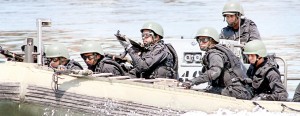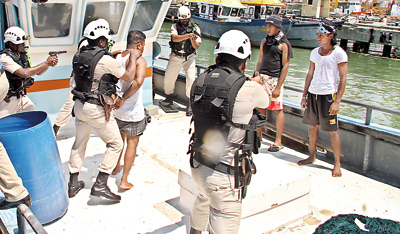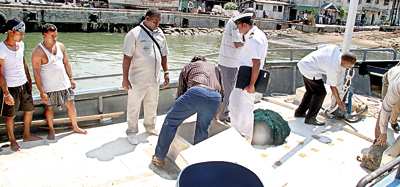News
Pact to track and identify Asian heroin labs
Indian Ocean countries launched a programme to identify regional opiate-manufacturing labs as a high-level United Nations-sponsored narcotics summit heard this week that Sri Lanka is a hub for trafficking to Asia and Australia.
The Compendium of Drug Seizures at Sea (October 2015) will be a joint effort by the United Nations Office on Drugs and Crime (UNDOC) and the Combined Maritime Forces (CMF) to collate all drug detections in the Indian Ocean.
“This compendium will strengthen co-operation on where drugs are produced and how they are concealed and shipped,” the Head of Global Maritime Crime Programme at UNDOC, Alan Cole, said, adding that officials would be able to track manufacturers by sharing information on purity and heroin stamps of seized narcotics.
Mr. Cole said drugs pass through Sri Lanka cheaply with the connivance of local agents and are then sent on long sea journeys to their destination.

On the hunt for drug traffickers: The Navy conducts a mock operation this week. Pix by Indika handuwala (above and below)
Speaking this week at the Indian Ocean Region’s Senior Drug Enforcement Officials’ Meeting held from October 13-15, the UN official said Sri Lanka had the political will and a very clear strategy to wipe out the drug menace in this country but those strategies needed to be implemented properly. It was an extremely difficult task, he underlined.
“Sri Lanka has the proper strategies with necessary resources, but proper implementation is the key,” Mr. Cole said.
“We are offering technical assistance and training for 21 countries including Sri Lanka in the region.”
Mr. Cole said the recently-concluded conference had achieved two significant matters: regional co-operation and exchanging training activities, and real-time intelligence sharing to tackle the drug menace.
“There is much improvement in law enforcement exchanges,” he said. “It is possible for a policeman in East Africa to make a call to a policeman in Pakistan or in Sri Lanka to give information to track the drug smuggling vessel in order to make an arrest.”
The Sri Lankan Navy had a formidable reputation for maritime security and was extremely well-trained and equipped, Mr Cole said, commenting on the Lankan Navy’s capabilities to counter drug-smuggling. He noted that no navy in the world was 100 per cent successful on counter-measures.
Under the compendium and other pacts agreed on at this week’s meeting Indian Ocean states will be able to gain highly-specialised training supported by UNODC in maritime law enforcement, capacity building for purity testing, training in controlled deliveries, establishment of transnational organised crime units and analytical software tools.
| Fishermen traffickers hard to stopWith Indian trawler poaching persisting in Lankan waters, one of the navy’s main concerns is drug trafficking through fishing vessels, Navy Commander Vice Admiral Ravindra Wijegunaratne said. The commander said the navy had several times apprehended Indian fishermen trafficking drugs to Sri Lanka with the help of the local fishermen. Nevertheless, he added, “It is practically impossible to check each and every fishing vessel that leaves and enter the country. When local fishing vessels mingle with a large number of Indian trawlers especially during the dark hours, monitoring becomes an impossible task. “Those who are engaged in trafficking drugs via the Palk Strait are well aware of these conditions and take maximum advantage of it. It is also said that on average, heroin seized in India destined for Sri Lanka is roughly two to three times the quantity of heroin seized in Sri Lanka itself,” Vice Admiral Wijegunaratne said. |
“UNDOC will be able to improve the police and Lanka drug agencies’ law enforcement resources and training. We will also help them to initiate early measures on how to reduce the demand for drugs, reducing effect and health issues,” Mr Cole said.
Sri Lanka’s navy commander noted that the country’s authorities apprehend only 10 per cent of the drugs coming into Sri Lanka.

Head of Global Maritime Crime Programme at UNDOC, Alan Cole
“The vastness of the ocean is a major challenge to any navy,” Vice Admiral Ravindra Wijegunaratne said.
“We have a coastline of 1,340km and an Exclusive Economic Zone that is eight times the land area and a search-and-rescue area that is 27 times the land area.
And most likely, we will be vested with an ocean area 24 times the land area in the future once the claims for delimitation of the outer limits of the continental margin are finalised,”
Commander Wijegunaratne highlighted the recent successful interception of a small dhow, smuggling 427kg of heroin in the Indian Ocean, by the Australia’s HMAS Melbourne.
“In fact they shared their experience with us when they were here in Colombo. Such connections go a long way,” he said.
Around 3.5 tons of heroin are smuggled to Sri Lanka each year, considerably in excess of the requirements of drug-dependent persons in the country, Commander Wijegunaratne said.
There were around 45,000 addicts in the country, using 763kg of heroin a year, a consumption value of Rs. 450 million, the Navy chief said.
He pointed to the President Maithripala Sirisena’s firmpolicy to create a drug-free Sri Lanka and said: “This is our strategy, and the Sri Lanka Navy in particular has a huge role to play.”
At the conclusion of the meeting on Thursday, Mr. Cole gave a demonstration at the Colombo naval base on search techniques to identify concealed compartments in fishing vessels.

